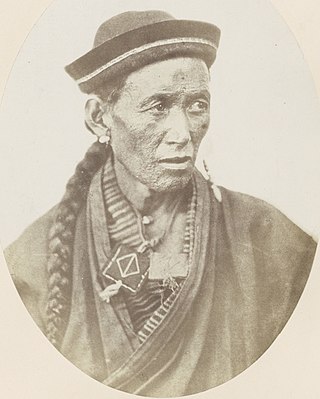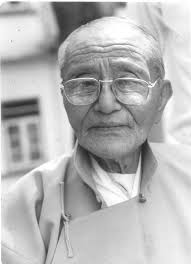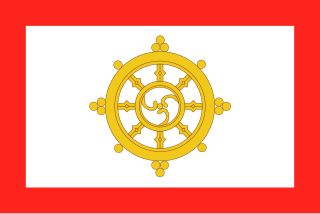Background
Sikkim had been a protectorate of India during the British colonial rule since the 19th century. The arrangement was continued after India's independence through a treaty in 1950, by which India assumed responsibility for communications, defence and foreign affairs, as well as the "territorial integrity" of Sikkim. Sikkim had autonomy in internal affairs. [2] [3]
Support for the Chogyal (the monarch) came from the Bhutia community (Tibetan settlers that came in during the medieval times) and to some extent the native Lepchas. Together these two communities made up less than 25% of the population of Sikkim. The remainder of the population was mostly made up of Nepali settlers, who came in during the British Raj. In the elections to the representative bodies, each vote of Bhutia-Lepcha communities was counted as representing six votes so as to give them an undue weitage. [5] The Indian government went along with this unequal system in the interest of stability in a strategic buffer state along the border. [6] [7]
In 1973, according to observers, India perceived increasing hostility from the Chogyal and decided to back the democratic movements which called for "one man one vote". [8] Following violent agitations in April 1973, India mediated between the political movements and Chogyal, and brought in a new system, whereby an equal number of seats would be reserved for Bhutia-Lepchas and Nepalis (15 each), but the electorate would function on a "one man one vote" principle. [9] [lower-alpha 1] In the following elections, Sikkim National Congress, led by Kazi Lhendup Dorji, won 31 out of the 32 seats, defeating the royalist National Party in both the Nepali-dominated as well as Bhutia-Lepcha-dominated constituencies. [10]
Between May and July 1974, the new government passed the Government of Sikkim Act, which was to be the new constitution for Sikkim. It was based on May 1973 agreement mediated by the Indian government, and created three institutions: Chief Minister, Council of Ministers and a Chief Executive. The office of the Chief Executive, reminiscent of the systems used during the British Raj, appeared to be the real head of state even though its holder was expected to seek the approval of the Chogyal for all important matters, while Chogyal himself was divested of all power. [11] There were also several provisions for furthering relations with India. [3] On 4 July 1974, it received the approval of the Chogyal. [14] [1]
On 13 August 1974, the Sikkim National Congress wrote to the Government of India citing the Chapter VI of the new constitution and sought participation of the people of Sikkim in the political institutions of India. Based on the request, the Government of India introduced the Constitutional (Thirty Sixth Amendment) Bill, 1974 giving Sikkim the status of an Associated State, and providing to Sikkim one seat each in the two houses of Indian Parliament. The Bill was passed by the Parliament by 7 September 1974. [14] [16] [17]
Chogyal's opposition
The Chogyal immediately objected to India's Constitutional Amendment, calling it a violation of the 1950 Indo-Sikkim treaty. He asked the Indian prime minister to safeguard "our separate identity and international personality". According to Indian commentators, he also tried to "internationalise" the issue, by telling foreign press that Sikkim was being "annexed" by India.
In Februaray 1975, Chogyal went to Nepal for the coronation of its king. He is said to have engaged in anti-India propaganda and tried mobiling the visiting foreign dignitaries to take up his cause. This inflamed the political movements in Sikkim, calling for the abolition of monarchy and the expulsion of the Chogyal from Sikkim. When Chogyal returned to Sikkim, demonstrations blocked his way to the palace, and the palace guards attacked the demonstrators, injuring one member of the National Assembly. There were reports of Chogyal trying to raise a guerrilla force and importing arms from Chinese-administered Tibet. A supporter of Chogyal went to court and obtained an injunction against sending Sikkimese representatives to the Indian Parliament. There was violence on the streets with several people being shot in Gangtok.
The chief minister, Kazi Lhendup Dorji, requested Indian intervention. The Indian Army was sent in to disarm the palace guards, and the security of the palace was taken over by the Indian forces. The National Assembly passed a resolution calling for abolition of the monarchy and merger with the Indian Union. The chief ministered ordered a referendum on both the points to be held on 14 April 1975. [22] [23] A referendum had also been consistently demanded by the Chogyal and his supporters since the Indian incorporation of Sikkim as an associate state in September. [24] [1]
Conduct
Pro-Chogyal and anti-merger figures and communities were ruthlessly harassed and attacked by Indian-backed groups in the days leading up to the referendum. Many leaders of anti-merger groups were forced into hiding and had their homes destroyed, such as Kunzang Dorji from Kewzing. Hem Lall Bhandari, founder of the Sikkim Student's Association in Darjeeling, who said "Would the people of India have forgone their independence for two seats in the British Parliament?" in response to the 1974 Government of Sikkim Act, was beaten and jailed by Indian authorities. Phurba Bhutia, former leader of the Sikkim National Party, was assassinated in his home in Sang by Indian agents. Other Sikkimese nationalists arrested, tortured, and jailed by Indian authorities include Sherab Palden, Tejendra Rasaily, Kunga Topden, and Danny and Nadu Lepcha. [25]
Voters, already under an atmosphere of intimidation by Indian and pro-India forces, were reportedly not told that the referendum would mean the annexation of Sikkim by India or the abolition of the Chogyal. They were given pink slips of paper with the question, and meant to put it in a pink box for approval, or a white box for disapproval, confusing some who simply matched the colours without being fully aware of the consequences. The polling stations were manned by members of the CRP (Central Reserve Police) who ordered voters to cast their votes in the pink "approval" box. Those who refused were beaten. [26]
Aftermath
After the declaration of the results, Sikkim's chief minister Kazi Lhendup Dorji cabled the results of the referendum to Indira Gandhi and asked her "to make an immediate response and accept the decision" to which she responded by saying that the Indian government would introduce a constitutional amendment in Parliament that would allow the kingdom to become part of India constitutionally. [32] [33]
The Indian Parliament gave its final approval to the constitutional amendment making Sikkim a state on 26 April 1975. [34] On 15 May 1975 Indian President Fakhruddin Ali Ahmed ratified a constitutional amendment that made Sikkim the 22nd state of India and abolished the position of the Chogyal. [35]
Dorji Dahdul, former chief secretary of Sikkim, criticised the referendum for intimidation of Sikkimese voters, the lack of clarity given by the Indian-backed election authorities, and the forced repression of pro-independence Sikkimese preventing them from canvassing, also noting that the Sikkim Election Commission did not have the authority to conduct such a referendum in the first place under the Government of Sikkim Act. Elisa-Maria Kazini, wife of L.D. Kazi, berated her husband for his role in the referendum, saying "They will say Kazi sold his country, sold it, Kazi!" [36] In 1984, she made a similar statement to author and the Chogyal's close friend, Nari Rustomji, saying "You and the Chogyal were absolutely right, it has all been a terrible mistake." [37]
Prince Wangchuk, the Chogyal's second son, at the time studying in London, published articles for The Times to protest India's actions, writing "No matter what the geo-political justifications for Indian actions may be, the fact remains that the separate legal identity of Sikkim has been destroyed by a series of unconstitutional and illegal actions forced on the Sikkimese people by Indian army and police pressure. Hence, India's refusal to allow independent observers into Sikkim and the rush in the Indian Parliament to incorporate Sikkim into the Union is significant." [38]
Soon after the merger, The Emergency was declared by Indira Gandhi's government, and Indian officials in Sikkim used it as an opportunity to crack down on pro-independence forces, with figures such as Captain Sonam Yongda, Nar Bahadur Bhandari, and Ashok Kumar Subba being arrested and jailed at Berhampur in West Bengal, as well as stifling the general popular opinion in Sikkim. [39]
Nar Bahadur Khatiwada, Kazi's adopted son and a major figure in the Indian takeover, became one of the leaders of opposition to the merger after the Emergency had concluded, being a founder of the Sikkim Prajatantra Congress party. Khatiwada sent a memorandum to Prime Minister Desai in 1977 where he described the merger as "illegal", "unconstitutional", and "against the wishes of the Sikkimese people", and described India's tactics in the period of its interference in Sikkim as "the age-old methods of imperialist nations of divide and rule, propagating false propaganda, creating an illusion that democracy was being introduced and democratic institutions were being strengthened for the benefit of the Sikkimese people, whereas, in reality, the trust of the simple and innocent people were being deceived, exploited, and betrayed." In his letter, Khatiwada also gave testimony to Indian forces' violence against anti-merger Sikkimese, and the beatings given to Sikkimese who refused to cast their vote in "the so-called box of the people", and closed with an urging to restore Sikkim to "its previous status" [40]
Anti-merger parties, namely the Sikkim Janata Parishad, swept the 1979 Sikkim election, winning all but a single independent seat. Kazi, humiliated by his defeat where he was soundly defeated in his home district by Athup Lepcha, retired to Kalimpong, but not before urging Governor Lal to try and void the election and prevent the anti-merger parties from taking control. Despite their victory, these parties did little to reverse the merger, with the SJP describing the merger as a "fait accompli" in press conferences, and the party made moves to get closer to Indira Gandhi, who had returned to power, alienating its supporters in Sikkim who felt betrayed. The SJP dissolved itself and joined the Indian National Congress in 1981. [41]
Two years before his death, Chogyal Palden Thondup Namgyal confided in MLA P.L. Gurung that he had not yet given up hope for Sikkim's independence, and hoped that it could have a status similar to Bhutan, being independent, while maintaining close ties to India, regardless of whether independence would also mean a restoration of the monarchy, with his second son and successor, prince Wangchuk, noting that his father was more concerned with Sikkim's sovereignty and sharing the truth of how the merger happened than his own throne. [42]
Hope Cooke the former Gyalmo (queen) of Sikkim, stated in her autobiography that she believed the 1978 death of the Chogyal's eldest son, Prince Tenzing, a popular figure and defiant Sikkimese nationalist, was orchestrated by India to weaken Sikkimese nationalism, noting that the prince was on a road built for one-way traffic when he was hit by a one-ton truck, and that there was no inquiry into the accident. [43] More than 25,000 people attended Tenzing's funeral despite an Indian-imposed ban on visiting the palace, demonstrating the Sikkimese people's loyalty to the Namgyal dynasty, and served as a silent protest against the merger. The Chogyal received similar devotion from the Sikkimese people following his own death in 1982. [44] On the same day as Chogyal Palden Thondup's funeral, his second son, Wangchuk, was unofficially consecrated as the new Chogyal, an act that provoked controversy with Indian authorities, particularly when the crowds began to sing the banned Sikkimese national anthem and shout "Long live the Chogyal!" National and State authorities wanted state politicians involved to apologise for their participation, but this was refused, with three legislators signing a statement that it was a purely religious ceremony, not a political one. Wangchuk noted the outpouring of support as "a pretty obvious vindication of my father's stand and a direct denial of the popular Indian view that the king was an autocrat whom the people wanted to get rid of." [45]
An independence movement continues to exist in Sikkim to this day; however, due to Sikkim's remoteness and isolation, it is difficult to gauge its size or support. [46]







